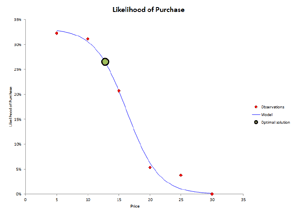| What you put in... | What you get out... |
|
|
The Pricing model introduced in Marketing Engineering for Excel version 2 is based on the Gabor-Granger method, which offers a relatively simple approach to estimate customer’s willingness to buy at different price points (and to interpolate between these price points).
 The Pricing model works as follows:
The Pricing model works as follows:
- Respondents are asked to indicate their buying intention for a product at a number of different price levels (at least 3, usually more). They answer on a Likert scale ranging from “will never buy” to “will definitely buy”.
- These answers are transformed into purchasing probabilities. Although the exact probabilities might vary depending on the context, the product, the industry, or experience, respondents are notoriously known to overstate their purchase likelihood. For instance, a respondent who indicates that he will “definitely buy” might be assigned an actual purchase probability of 50% or less.
- These probabilities are aggregated and a response function is fit on the data, such that the aggregate demand level can be estimated at any price level.
The Gabor-Granger method is especially suited for optimizing price when all the other components (or attributes) of the product or service are fixed and cannot be changed. When the firm can change product attributes other than price (e.g., design, quality, power), it would be more appropriate to use conjoint analysis, where price is only one of the attributes among many.
Associated Videos
The following video(s) are archived recordings of previous webinars discussing the Pricing model. These videos are intended for instructor viewing only as many times they discuss actual business case solutions.
Videos are only available for Registered Instructors
